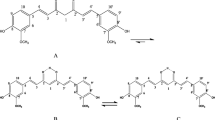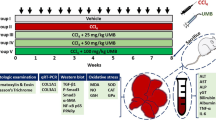Abstract
Liver fibrosis is a major health problem that can lead to the development of liver cirrhosis and hepatocellular carcinoma. On the other hand, several antioxidants have been shown to possess protective effect against liver fibrosis. Therefore, in the present work, the effectiveness of curcumin, α-lipoic acid, and N-acetylcysteine in protecting against carbon tetrachloride (CCl4)-induced liver fibrosis as well as the mechanism(s) implicated in this protective effect was studied. The antioxidants used in this study resulted in hepatoprotective effect as evident by substantial decreases in collagen deposition in histopathological examinations in addition to significant decrease in serum levels of alanine aminotransferase, aspartate aminotransferase, gamma glutamyl transpeptidase, bilirubin, and transforming growth factor-alpha (TGF-α) as well as hepatic malondialdehyde concentration, with a concurrent increase in serum matrix metalloproteinase-13 (MMP-13) and hepatic reduced glutathione (GSH) levels as compared to CCl4 fibrotic group. In conclusion, curcumin, α-lipoic acid, and N-acetylcysteine protect rats against CCl4-induced liver fibrosis most possibly through their antioxidant activities and their capacities to induce MMP-13 and to inhibit TGF-α levels.




Similar content being viewed by others
References
Bataller R, Brenner DA (2005) Liver fibrosis. J Clin Invest 115:209–218
Bedossa P, Houglum K, Trautwein C, Holstege A, Chojkier M (1994) Stimulation of collagen alpha 1(I) gene expression is associated with lipid peroxidation in hepatocellular injury: a link to tissue fibrosis? Hepatology 19:1262–1271
Buege JA, Aust SD (1978) Microsomal lipid peroxidation. Methods Enzymol 52:302–310
Fallowfield JA, Mizuno M, Kendall TJ, Constandinou CM, Benyon RC, Duffield JS, Iredale JP (2007) Scar-associated macrophages are a major source of hepatic matrix metalloproteinase-13 and facilitate the resolution of murine hepatic fibrosis. J Immunol 178:5288–5295
Franco R, Schoneveld OJ, Pappa A, Panayiotidis MI (2007) The central role of glutathione in the pathophysiology of human diseases. Arch Physiol Biochem 113:234–258
Fu Y, Zheng S, Lin J, Ryerse J, Chen A (2008) Curcumin protects the rat liver from CCl4-caused injury and fibrogenesis by attenuating oxidative stress and suppressing inflammation. Mol Pharmacol 73:399–409
Galicia-Moreno M, Rodríguez-Rivera A, Reyes-Gordillo K, Segovia J, Shibayama M, Tsutsumi V, Vergara P, Moreno MG, Muriel P (2009) N-Acetylcysteine prevents carbon tetrachloride-induced liver cirrhosis: role of liver transforming growth factor-beta and oxidative stress. Eur J Gastroenterol Hepatol 21:908–914
Issa R, Zhou X, Trim N, Millward-Sadler H, Krane S, Benyon C, Iredale J (2003) Mutation in collagen-1 that confers resistance to the action of collagenase results in failure of recovery from CCl4-induced liver fibrosis, persistence of activated hepatic stellate cells, and diminished hepatocyte regeneration. FASEB J 17:47–49
Ito K, Kajikawa S, Nii A, Doi K (2005) Nitrofurazone-induced gene expressions in rat hepatocytes and their modification by N-acetylcysteine. Exp Toxicol Pathol 56:333–339
Jin H, Yamamoto N, Uchida K, Terai S, Sakaida I (2007) Telmisartan prevents hepatic fibrosis and enzyme-altered lesions in liver cirrhosis rat induced by a choline-deficient L-amino acid-defined diet. Biochem Biophys Res Commun 364:801–807
Kato J, Sato Y, Inui N, Nakano Y, Takimoto R, Takada K, Kobune M, Kuroiwa G, Miyake S, Kohgo Y, Niitsu Y (2003) Ethanol induces transforming growth factor-alpha expression in hepatocytes, leading to stimulation of collagen synthesis by hepatic stellate cells. Alcohol Clin Exp Res 27:58S–63S
Knodell RG, Ishak KG, Black WC, Chen TS, Craig R, Kaplowitz N, Kiernan TW, Wollman J (1981) Formulation and application of a numerical scoring system for assessing histological activity in asymptomatic chronic active hepatitis. Hepatology 1:431–435
Lee KS, Buck M, Houglum K, Chojkier M (1995) Activation of hepatic stellate cells by TGF alpha and collagen type I is mediated by oxidative stress through c-myb expression. J Clin Invest 96:2461–2468
Manibusan MK, Odin M, Eastmond DA (2007) Postulated carbon tetrachloride mode of action: a review. J Environ Sci Health C Environ Carcinog Ecotoxicol Rev 25:185–209
Melhem MF, Craven PA, Liachenko J, DeRubertis FR (2002) Alpha-lipoic acid attenuates hyperglycemia and prevents glomerular mesangial matrix expansion in diabetes. J Am Soc Nephrol 13:108–116
Min AK, Kim MK, Seo HY, Kim HS, Jang BK, Hwang JS, Choi HS, Lee KU, Park KG, Lee IK (2010) Alpha-lipoic acid inhibits hepatic PAI-1 expression and fibrosis by inhibiting the TGF-beta signaling pathway. Biochem Biophys Res Commun 393:536–541
Pereira-Filho G, Ferreira C, Schwengber A, Marroni C, Zettler C, Marroni N (2008) Role of N-acetylcysteine on fibrosis and oxidative stress in cirrhotic rats. Arq Gastroenterol 45:156–162
Pinlaor S, Prakobwong S, Hiraku Y, Pinlaor P, Laothong U, Yongvanit P (2010) Reduction of periductal fibrosis in liver fluke-infected hamsters after long-term curcumin treatment. Eur J Pharmacol 638:134–141
Rojkind M (1999) Role of metalloproteinases in liver fibrosis. Alcohol Clin Exp Res 23:934–939
Velasco-Loyden G, Pérez-Carreón JI, Agüero JF, Romero PC, Vidrio-Gómez S, Martínez-Pérez L, Yáñez-Maldonado L, Hernández-Muñoz R, Macías-Silva M, de Sánchez VC (2010) Prevention of in vitro hepatic stellate cells activation by the adenosine derivative compound IFC305. Biochem Pharmacol 80:1690–1699
Weber LW, Boll M, Stampfl A (2003) Hepatotoxicity and mechanism of action of haloalkanes: carbon tetrachloride as a toxicological model. Crit Rev Toxicol 33:105–136
Wu SJ, Tam KW, Tsai YH, Chang CC, Chao JC (2010) Curcumin and saikosaponin a inhibit chemical-induced liver inflammation and fibrosis in rats. Am J Chin Med 38:99–111
Conflict of interest
The authors declare that there are no conflicts of interest.
Author information
Authors and Affiliations
Corresponding author
Rights and permissions
About this article
Cite this article
Morsy, M.A., Abdalla, A.M., Mahmoud, A.M. et al. Protective effects of curcumin, α-lipoic acid, and N-acetylcysteine against carbon tetrachloride-induced liver fibrosis in rats. J Physiol Biochem 68, 29–35 (2012). https://doi.org/10.1007/s13105-011-0116-0
Received:
Accepted:
Published:
Issue Date:
DOI: https://doi.org/10.1007/s13105-011-0116-0




